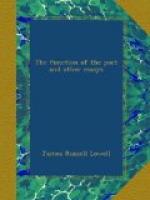The more important part of Mr. Forster’s fresh material is to come in future volumes, if now, alas! we are ever to have them. For some of what he gives us in this we can hardly thank him. One of the manuscripts he has unearthed is the original version of “Baucis and Philemon” as it was before it had passed under the criticism of Addison. He seems to think it in some respects better than the revised copy though in our judgment it entirely justifies the wisdom of the critic who counselled its curtailment and correction. The piece as we have hitherto had it comes as near poetry as anything Swift ever wrote except “Cadenus and Vanessa,” though neither of them aspires above the region of cleverness and fancy. Indeed, it is misleading to talk of the poetry of one whose fatal gift was an eye that disidealized. But we are not concerned here with the discussion of Swift’s claim to the title of poet. What we are concerned about is to protest in the interests of good literature against the practice, now too common, of hunting out and printing what the author would doubtless have burned. It is unfair to the dead writer and the living reader by disturbing that unitary impression which every good piece of work aims at making, and is sure to make, only in proportion to the author’s self-denial and his skill in
The last and greatest art, the art to blot.
We do not wish, nor have we any right to know, those passages through which the castigating pen has been drawn.
Mr. Forster may almost claim to have rediscovered Swift’s journals to Esther Johnson, to such good purpose has he used them in giving life and light to his narrative. He is certainly wrong, however, in saying to the disparagement of former editors that the name Stella was not invented “till long after all the letters were written.” This statement, improbable in itself as respects a man who forthwith refined Betty, Waring, and Vanhomrigh into Eliza, Varina, and Vanessa, is refuted by a passage in the journal of 14th October, 1710, printed by Mr. Forster himself. At least, we know not what “Stellakins” means unless it be “little Stella.” The value of these journals for their elucidation of Swift’s character cannot be overestimated, and Mr. Forster is quite right in insisting upon the importance of the “little language,” though we are by no means sure that he is always so in his interpretation of the cipher. It is quite impossible, for instance, that ME can stand for Madam Elderly, and so for Dingley. It is certainly addressed, like the other endearing epithets, to Esther Johnson, and may mean My Esther or even Marry Esther, for anything we know to the contrary.




